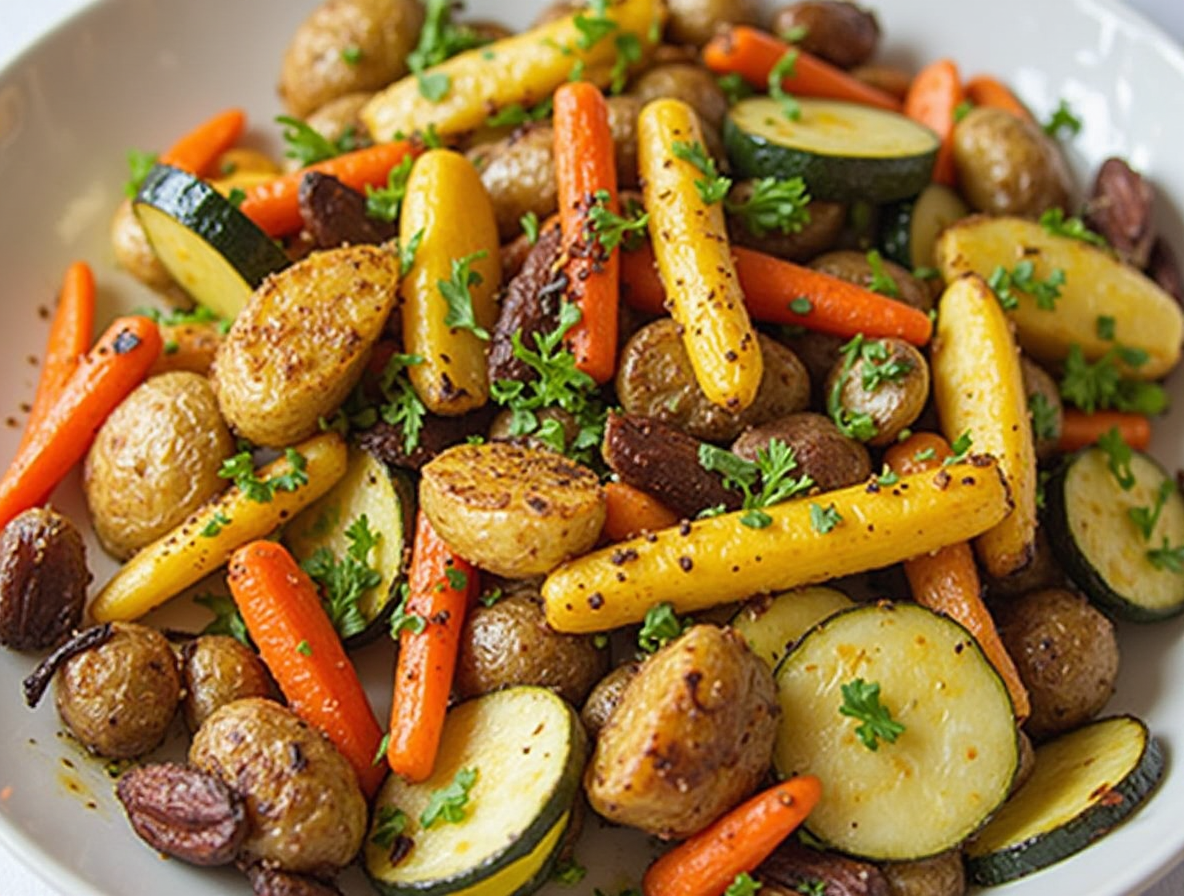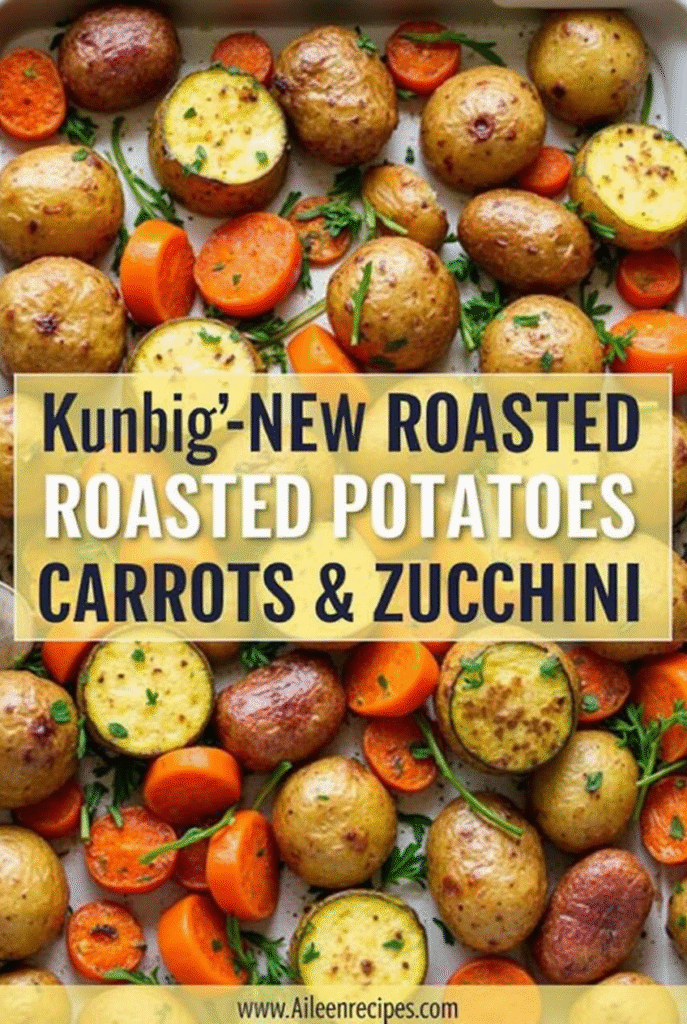How to Make Perfect Garlic Herb Roasted Potatoes, Carrots and Zucchini (That Never Fail)
Garlic herb roasted potatoes carrots and zucchini might just be the most versatile side dish in my recipe collection. Certainly, it’s no coincidence that this colorful medley is gluten-free, dairy-free, vegan, and Whole30 compatible—making it perfect for almost any dietary preference at your table.
When I’m short on time but still want something nutritious, this roasted potatoes and vegetables combination comes to my rescue. With just 15 minutes of prep and about 35 minutes of cooking time, I can create a delicious side dish that’s packed with fiber, vitamins, and antioxidants. Additionally, at approximately 180 calories per serving, these garlic roasted potatoes and carrots deliver impressive nutrition without weighing down your meal. The herb roasted potatoes and carrots develop those irresistible crispy edges while maintaining tender centers, creating the perfect texture contrast.
In this guide, we’ll walk through my foolproof method for roasting potatoes, carrots and zucchini that never disappoints. From selecting the best ingredients to mastering the roasting technique, you’ll discover how simple adjustments—like adding fresh herbs and roasting in stages—can transform ordinary vegetables into an extraordinary dish that everyone will request again and again.
Choosing the Right Ingredients for Garlic Herb Roasted Potatoes and Veggies
The foundation of perfect garlic herb roasted potatoes, carrots, and zucchini begins with selecting quality ingredients. Each component plays a crucial role in creating that irresistible combination of crispy exteriors and tender interiors.
Best type of potatoes for roasting
For roasting, you need potatoes that hit the sweet spot between waxy and starchy. Yukon Gold potatoes reign supreme as the best choice according to chefs. Their natural buttery flavor and perfect balance means they “crisp beautifully on the exterior but remain fluffy, creamy, and moist in the middle”.
German Butterballs make an excellent alternative with their thin, flaky skin and subtle buttery taste. Fingerling potatoes, with their sweet and slightly nutty flavor, also work wonderfully. In contrast, red potatoes tend to roast up dark but struggle to maintain crispness.
How to pick fresh carrots and zucchini
When selecting zucchini, look for ones with smooth, bright green skin free from nicks and bruises. The best zucchinis are 6-8 inches long with a large portion of stem still attached, as shorter stems indicate quicker loss of freshness.
For carrots, any variety works well for roasting. If you want visual appeal, consider colorful options like Kaleidoscope carrots. Remember that unpeeled vegetables often taste better since “the outer layer browns when baked and gives a deeper flavor”.
Fresh vs dried herbs: what works best
Fresh herbs provide “a wider and more interesting spectrum of tastes” compared to dried. However, dried herbs have their place in roasted vegetable dishes.
Specifically, oregano, marjoram, thyme, rosemary, and bay leaf maintain excellent flavor when dried. In contrast, delicate herbs like parsley, cilantro, and basil lose much of their distinctive flavor in dried form.
As a rule of thumb, add dried herbs earlier in cooking to allow them time to rehydrate and release their flavors. Fresh herbs work best added toward the end of cooking or as a garnish.
Why garlic is essential for flavor
Garlic transforms simple roasted vegetables into something extraordinary. Indeed, it’s a “flavor powerhouse that brings the simplest foods to life”. When roasted, garlic undergoes a remarkable transformation—its strong, almost spicy raw flavor mellows into something sweet and surprisingly subtle.
Beyond flavor, garlic offers immune-boosting benefits. For best results with roasted vegetables, add minced garlic later in the cooking process to prevent burning while maintaining its fresh flavor.
Step-by-Step Guide to Roasting Potatoes, Carrots, and Zucchini
The process of roasting potatoes, carrots, and zucchini to perfection requires attention to specific techniques. Following these steps will ensure you achieve that ideal combination of caramelized exteriors and tender interiors.
1. Preheat and prep your oven
Set your oven to 400-425°F – this temperature range is ideal for achieving caramelization without burning. A properly preheated oven is essential for crispy, evenly roasted vegetables. Furthermore, placing your baking sheet in the oven while it preheats can jump-start the cooking process and help vegetables brown more quickly.
2. Cut vegetables evenly for uniform cooking
Cut your vegetables into pieces of similar size to ensure they cook at the same rate. For potatoes and carrots, aim for ½-1 inch pieces. Essentially, uniform cutting prevents some pieces from burning while others remain undercooked. Zucchini cooks faster than root vegetables, so you can leave these pieces slightly larger.
3. Toss with olive oil, garlic, and herbs
In a large bowl, toss vegetables with enough olive oil to give them a light, glossy coating—approximately 2-3 tablespoons for a full sheet pan. Next, add minced garlic, dried herbs like rosemary and thyme, salt, and pepper. Toss thoroughly until all pieces are evenly coated.
4. Roast in stages for perfect texture
Rather than cooking everything together:
- Start with potatoes and carrots first (they take longest), roasting for 20 minutes
- Meanwhile, prepare zucchini with oil and seasoning separately
- Add zucchini to the partially cooked root vegetables
- Continue roasting everything together for 15-20 minutes more
This staged approach prevents overcooking delicate vegetables while ensuring root vegetables are perfectly tender.
5. Check for doneness and serve
Vegetables are done when they’re fork-tender and golden brown around the edges. Gently toss halfway through cooking for even browning. The potatoes should have crispy exteriors, carrots should be caramelized, and zucchini should be tender but not mushy. Transfer to a serving dish immediately after removing from the oven.
Tips to Make Garlic Herb Roasted Potatoes and Carrots That Never Fail
Even with the best ingredients and basic cooking methods mastered, mastering a few strategic techniques can dramatically improve your garlic herb roasted potatoes and carrots. These simple yet effective tips elevate ordinary roasted vegetables into consistently perfect side dishes.
Avoid overcrowding the baking sheet
Giving vegetables space on the baking sheet is perhaps the most critical factor in successful roasting. Initially, I’d pile everything onto one pan, but this creates steam instead of caramelization. For properly roasted vegetables, arrange them in a single layer with at least a quarter inch between pieces. Undoubtedly, this might mean using two baking sheets, but the improved results justify washing an extra pan. Remember that crowded vegetables steam rather than roast, resulting in limp, less flavorful outcomes.
Use parchment paper for easy cleanup
Parchment paper offers more benefits than just easier cleanup. Notably, it prevents vegetables from sticking slightly better than foil. Unlike aluminum foil, parchment doesn’t leach metal into acidic foods during high-heat cooking. Throughout my testing, I’ve found that vegetables on parchment cook more uniformly in color, while bare sheet pans create the most caramelization. For temperature safety, remember parchment paper shouldn’t be used above 420-450°F.
Toss halfway through for even browning
Rotating the pan and flipping vegetables ensures even caramelization on all sides. During roasting, turn the baking sheet 180 degrees halfway through cooking time. Additionally, if using two racks, swap the pans’ positions. Gently toss with a spatula, ensuring vegetables resettle in a single layer.
Add garlic later to prevent burning
Garlic burns easily at high temperatures, creating bitter flavors. For recipes roasting longer than 30 minutes, I recommend using whole smashed garlic cloves instead of minced garlic. Otherwise, add minced garlic during the last 5-10 minutes of cooking. This prevents burning while maintaining fresh garlic flavor.
Try different herb combinations
Beyond classic rosemary and thyme, experiment with these combinations:
- Basil, rosemary and thyme for Mediterranean flavor
- Paprika, chili powder and brown sugar for sweet-spicy profile
- Fresh parsley with roasted garlic butter finish
Fresh woody herbs like rosemary and thyme withstand oven heat well, while delicate herbs like basil work better added after roasting.
Serving, Storing, and Reheating Roasted Vegetables
Once your garlic herb roasted potatoes, carrots, and zucchini come out of the oven, the journey of this versatile dish is just beginning. From complementary pairings to proper storage techniques, here’s how to maximize your roasted vegetable experience.
What to serve with roasted potatoes and vegetables
Garlic herb roasted potatoes and vegetables shine alongside almost any protein. For meat lovers, this colorful medley complements grilled chicken, turkey, steak, or pork chops beautifully. Fish enthusiasts will find these vegetables pair exceptionally well with salmon, tilapia, or cod. Moreover, vegetarian options abound—try serving over creamy hummus, fluffy quinoa, or with hearty grain bowls. For breakfast, these roasted vegetables can transform scrambled eggs into a nutritious morning feast.
How to store leftovers properly
After cooking, allow your garlic roasted potatoes and carrots to cool completely to room temperature—typically within 2 hours of removing from the oven. Thereafter, transfer to an airtight container; some cooks prefer using identical 9×13 containers for organization. Properly stored herb roasted potatoes and carrots remain fresh in the refrigerator for 3-4 days. First and foremost, avoid leaving them at room temperature for extended periods.
Best way to reheat without losing texture
The stovetop method yields the best results for maintaining texture. Heat 1 tablespoon olive oil in a skillet over medium heat, add vegetables in a single layer, and cook approximately 5 minutes, flipping halfway through. Alternatively, reheat in a 350°F oven for 10-15 minutes (ideal for maintaining crispness). Despite its convenience, microwaving often results in soggy vegetables, though it works in a pinch.
Can you freeze roasted vegetables?
Yes, roasted potatoes, carrots, and zucchini freeze well for up to 3-6 months. After cooling completely, pat dry with paper towels to remove excess moisture. Subsequently, flash freeze by arranging in a single layer on a baking sheet before transferring to airtight containers or freezer bags. For best results when using frozen vegetables, thaw overnight in the refrigerator before reheating in the oven or incorporate directly into soups and stews.
Conclusion
Final Thoughts on Perfect Garlic Herb Roasted Vegetables
Mastering these garlic herb roasted potatoes, carrots, and zucchini has completely transformed my approach to side dishes. Throughout this guide, we’ve explored everything from selecting the ideal potato varieties to perfecting the roasting technique. Most importantly, we’ve seen how simple ingredients combine to create something truly exceptional.
The beauty of this dish lies not only in its vibrant colors and flavors but also in its remarkable versatility. Whether paired with grilled chicken for a weeknight dinner or served alongside a holiday roast, these vegetables adapt effortlessly to any occasion. Additionally, their compatibility with nearly every dietary preference makes them a reliable choice for gatherings where various food restrictions might exist.
Remember those key techniques that guarantee success every time? Proper spacing on the baking sheet, staged cooking for different vegetables, and careful timing for adding garlic all contribute significantly to achieving that perfect balance of crispy exteriors and tender centers. These details might seem small, but they make all the difference between ordinary roasted vegetables and extraordinary ones.
Nutritional benefits certainly add another compelling reason to make this dish part of your regular rotation. The combination of fiber-rich vegetables, heart-healthy olive oil, and antioxidant-packed herbs creates a side dish that tastes indulgent while still supporting overall wellness. Consequently, you can feel good about serving seconds or incorporating leftovers into tomorrow’s meals.
I encourage you to start with this basic recipe, then gradually experiment with different herb combinations or vegetable substitutions based on seasonal availability. Before long, you’ll develop your own signature version that family and friends will associate specifically with your cooking. After all, the best recipes evolve through personal touches and adaptations.
These garlic herb roasted potatoes, carrots and zucchini have never failed me, regardless of the occasion or audience. Give this method a try, and I’m confident they’ll become a staple in your kitchen too.
FAQs
Q1. What’s the best way to ensure crispy roasted vegetables? To achieve crispy roasted vegetables, avoid overcrowding the baking sheet. Arrange vegetables in a single layer with space between pieces to promote caramelization rather than steaming. Use a high oven temperature (400-425°F) and toss vegetables halfway through cooking for even browning.
Q2. How can I prevent garlic from burning when roasting vegetables? To prevent garlic from burning, add it later in the cooking process. For recipes that roast longer than 30 minutes, use whole smashed garlic cloves instead of minced garlic. Alternatively, add minced garlic during the last 5-10 minutes of cooking to maintain its fresh flavor without burning.
Q3. What are the best potatoes for roasting? Yukon Gold potatoes are ideal for roasting due to their balanced starch content and natural buttery flavor. They crisp beautifully on the outside while remaining fluffy and creamy inside. German Butterballs and fingerling potatoes are also excellent choices for roasting.
Q4. Can roasted vegetables be frozen for later use? Yes, roasted vegetables can be frozen for up to 3-6 months. After cooling completely, pat them dry to remove excess moisture, then flash freeze on a baking sheet before transferring to airtight containers or freezer bags. Thaw overnight in the refrigerator before reheating for best results.
Q5. What’s the most effective way to reheat roasted vegetables? The stovetop method is best for maintaining texture when reheating roasted vegetables. Heat olive oil in a skillet over medium heat, add vegetables in a single layer, and cook for about 5 minutes, flipping halfway through. Alternatively, reheat in a 350°F oven for 10-15 minutes to maintain crispness.


